
Free coloring pages for kids of all ages
- • A Bug's Life [20]
- • Aladdin [48]
- • Alvin and the Chipmu [15]
- • Angry Birds [31]
- • Animals [458]
- • Baby Boss [17]
- • Barbie [145]
- • batman [54]
- • Ben & Holly's Little Kingdom [25]
- • Big Hero 6 [31]
- • Captain America [33]
- • Captain Underpants [12]
- • Cars [59]
- • Christmas [121]
- • Cinderella [47]
- • Coco [35]
- • Curious George [39]
- • Despicable Me [32]
- • Doc McStuffins [18]
- • Dora the Explorer [70]
- • doraemon [31]
- • Dragons [27]
- • Finding Dory [19]
- • Finding Nemo [23]
- • frozen [41]
- • halloween [56]
- • Hotel Transylvania [18]
- • How to Train Your Dragon [18]
- • Ice Age [68]
- • Insects [96]
- • Inside Out [19]
- • Iron Man [36]
- • Kirby [26]
- • Kung Fu Panda [34]
- • Lego Batman [9]
- • Letters and numbers [220]
- • Masha and the Bear [55]
- • Miraculous [20]
- • Moana [21]
- • Mr Peabody & Sherman [12]
- • My Little Pony [55]
- • Norm of the North [3]
- • PAW Patrol [45]
- • Peppa Pig [59]
- • PJ Masks [23]
- • Regal Academy [11]
- • Shimmer and Shine [26]
- • Sing [17]
- • Skylanders [132]
- • Snow White [21]
- • Sofia the First [17]
- • sonic boom [39]
- • Spiderman [72]
- • SpongeBob [42]
- • Star Wars [40]
- • Super Wings [31]
- • Tangled [21]
- • The Good Dinosaur [99]
- • The LEGO Movie [18]
- • The Little Mermaid [67]
- • The Powerpuff Girls [24]
- • The Secret Life of Pets [32]
- • The Smurfs [52]
- • Trolls [14]
- • Walking with Dinosaurs [5]
- • Yo-kai Watch [37]
- • Zootopia [25]
Coloring with markers
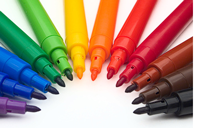
Markers are not a traditional tool of painting, they are quite recent instruments that belong more to the graphic design language; but we use them right from the school, they are familiar to everyone and can be a different way from the brush and pencil to give color to an idea fixed on a sheet.
The markers are the evolution of the ballpoint pen. They are made by a tank with colored inks, they have a tip in the synthetic fibers capable of ensuring a continuous stretch and are enclosed in a plastic casing.
They have a range of bright and transparent colors. For their color brilliance and for their extreme ease and speed of use, the markers are more suitable tools for execution of rapid drawings that need to communicate an idea, for which has importance also to the color effect.
What you need to color with markers
To start drawing serves an adequate assortment of markers, at least 36-48 colors; the number seems high but it is really the minimum required because you can not get real mixtures as in painting or mergers as in the drawing with colored pencils.
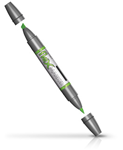 Some markers have two tips, usually one thin and the other one coarse, or one globose and the other one flat (similar to that of highlighters). With this variety of tips you can give rise to multiple types of stretch.
Some markers have two tips, usually one thin and the other one coarse, or one globose and the other one flat (similar to that of highlighters). With this variety of tips you can give rise to multiple types of stretch.
To store them properly we must avoid leaving them to air, so you must always close the cap. It is also important not to press the tip too hard on the sheet, especially if the tip is thin type. In fact it may bend or re-enter in the plastic cylinder that contains it.
How to use the markers
To fill in the blanks of the sheet you can use different techniques: hatching with parallel lines or continuous lines in a zigzag pattern, with pointillism or overlaying two or more colors.
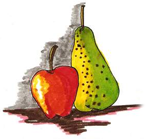 The color's gradations are realized by parallel stretches alongside similar colors (such as orange and red), from lightest to darkest; or by increasing the concentration of the lines in the hatch or the points in pointillism. Pass the same color over a previous layer reinforces increasing saturation, but be careful not to overdo it because it is easy to end up in "too dark". Given the vibrant nature of markers color on white paper, these are well suited to the realization of contrasts.
The color's gradations are realized by parallel stretches alongside similar colors (such as orange and red), from lightest to darkest; or by increasing the concentration of the lines in the hatch or the points in pointillism. Pass the same color over a previous layer reinforces increasing saturation, but be careful not to overdo it because it is easy to end up in "too dark". Given the vibrant nature of markers color on white paper, these are well suited to the realization of contrasts.
The color mixing can be created in many ways: 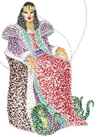 one of these is the pointillism, which allows, combining dots of different colors, to create the tones and shading. In any case, the color fusion occurs only in the visual perception level and not on the sheet. It takes much time and patience to fill in the blanks with points side by side but the effect is remarkable.
one of these is the pointillism, which allows, combining dots of different colors, to create the tones and shading. In any case, the color fusion occurs only in the visual perception level and not on the sheet. It takes much time and patience to fill in the blanks with points side by side but the effect is remarkable.
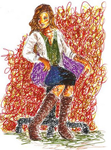 A similar approach, but more faster, is filling with doodles: the drawing on the left are used to fine tip markers, different colors mixing with the overlap of doodles and to a lesser extent the hatches.
A similar approach, but more faster, is filling with doodles: the drawing on the left are used to fine tip markers, different colors mixing with the overlap of doodles and to a lesser extent the hatches.
The most classic way to fill white space is to paint using horizontal sections side by side where the white of the paper disappears completely by creating compact color areas.